Part I: The standard accessories
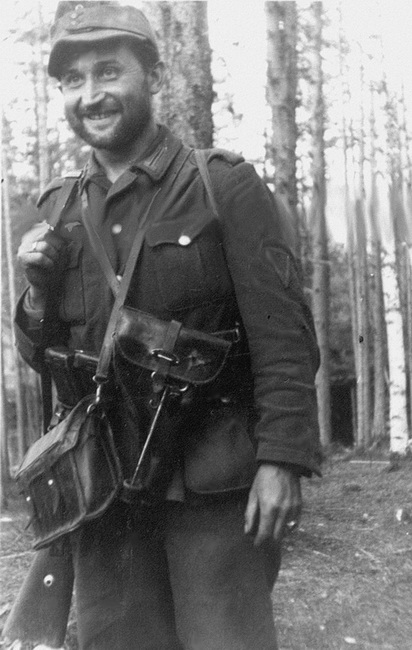
A smiling
Gebirgsjäger in Lappland 1943, carrying a matching set of flare gun
holster and flare
cartridge pouch in Preßstoff
The
standard equipment for the flare gun
included
a
holster with a carrying strap and an ejector rod, as well as an
ammunition pouch
that holds up to 18 cartridges, with the same type of carrying
strap. There
were also other items manufactured, but these were only used with the
flare gun
in special configurations or by the maintenance organization and will
be covered in part II.
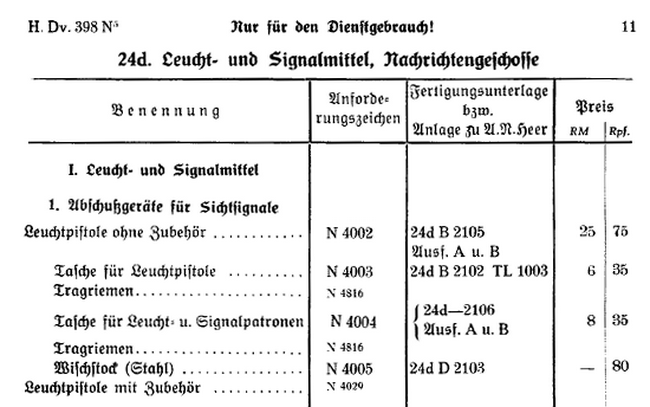
Holster
(N4003
Tasche für Leuchtpistole)
The holster was of a standard design and made of black leather. It did
not really alter from the basic design, apart from the length, from the
start of production in 1926 until the end in 1943. The earliest dated
example observed until
now was made in 1928. The lid was held in the
closed
position by a leather strap threaded through a metal loop. An external
cup at the bottom of the holster held the head of the ejector rod,
while a small leather strap with a buckle held the handle to the front
of the holster. The back was fitted with standard belt loops and two
D-rings for the carrying sling.
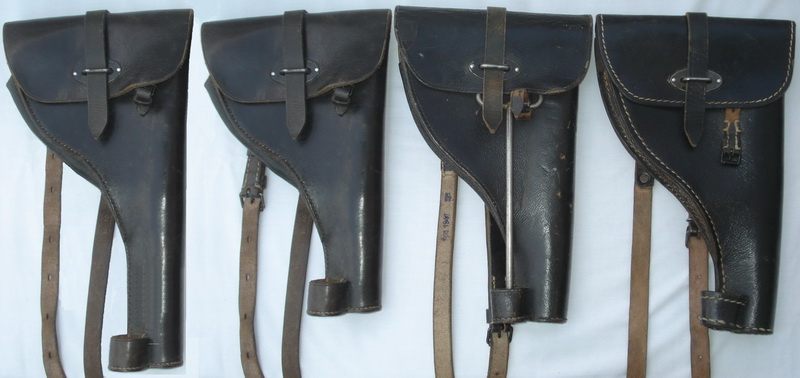
The four models of
the holster. The long model (Photoshop only) in leather, the standard
holster in leather, holster in Preßstoff with full lid, holster in
Preßstoff with hinged lid.
With the transition to a short barrel in 1935, the holster was
shortened to fit the shorter flare gun. Most of the existing long
holsters were also shortened to fit the flare guns that had been
modified. Because of this, the early long holsters are now extremely
rare.
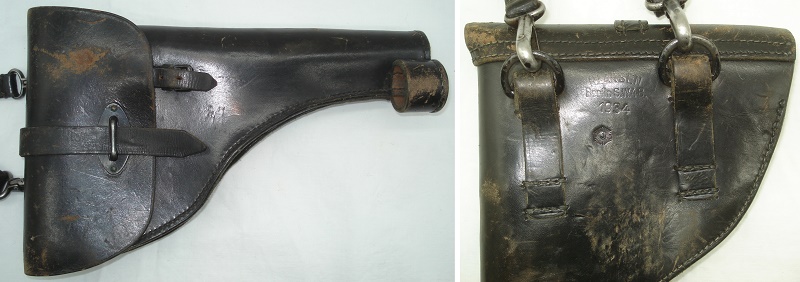
A standard length
holster, but manufactured in 1934 as a long holster.

The
evidence of the shortening is clearly visible here. The lower part of
the
holster has an uneven stitching,
and the bottom
shows the dyed end of
the ejector rod cup, while the rest is undyed, raw leather.
The stock number in the supply system did not change, so from the
"decisive moment"
the long holsters no longer existed, and had to be
shortened to "fit". Probably there are no more than a handful of these
left worldwide. I myself have only seen 3 altogether. The
standard (short) leather
holster was manufactured for the Wehrmacht until 1940. In 1940 the
production changed from leather to artificial leather (Preßstoff), when
leather became scarce. The new holster was given the official title "Leuchtpistolentasche
Ausfertigung B (Kunstleder)". The artificial leather,
however, could not replace real leather in all areas, so belt loops,
the closure strap and the strap for fastening the ejector rod were all
retained in leather. The curved “sidewall” could be either real leather
or Preßstoff,
depending on manufacturer.

Rear view of the
holsters. Leather, Preßstoff with sewn on lid and Preßstoff with
leather-hinged lid.
Preßstoff, also called
"cardboard leather" is artificial leather made
of laminated and impregnated paper fiber. It can be cut and stitched,
and has much of the same qualities as leather when used as "static"
material. On the other hand, it withstands movement and extended
exposure to moisture less well than leather, and is therefore not
suitable for some areas where leather is superior, such as belts,
straps and
footwear. Preßstoff can’t be stretched and flexed, especially in cold
weather. Due to this the users soon dicovered that the flare
gun holster in Preßstoff had
a weak point; the lid that had to be bent up and down each time the
flare gun went in and out of the holster. This usually meant that the
lid broke off in the area of the seams where it was sewn to the
holster. In 1940-41 the production changed,
and the lid was no longer sewn to the
holster. Instead, a strip of leather was riveted in between
the casing and the lid to act as a hinge.
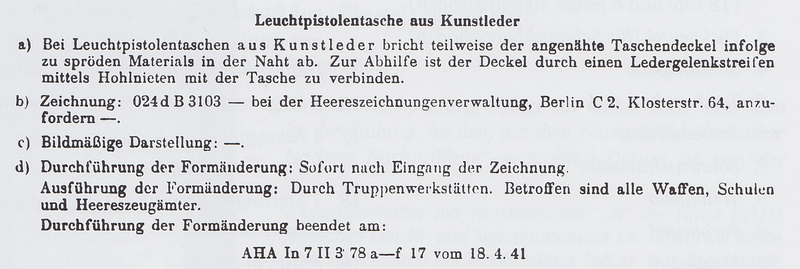
In Heeres Verordnungsblatt dated 18 April 1941, orders are issued to
repair all the holsters of artificial leather in use with this damage
in the same way. The job was to be done by the "Truppenwerkstätten",
the good old Waffenmeister.

A early 1940
manufactured Preßstoff holster with sewn lid
that has been converted according to the regulations with a
riveted leather-hinge.
The new version made
from Preßstoff with a hinged
lid remained in production until (early) 1944. The only change during
production time appears in 1943. The production of the holster is
simplified by replacing the seams of the belt loops and the small
leather strap of the ejector with rivets.
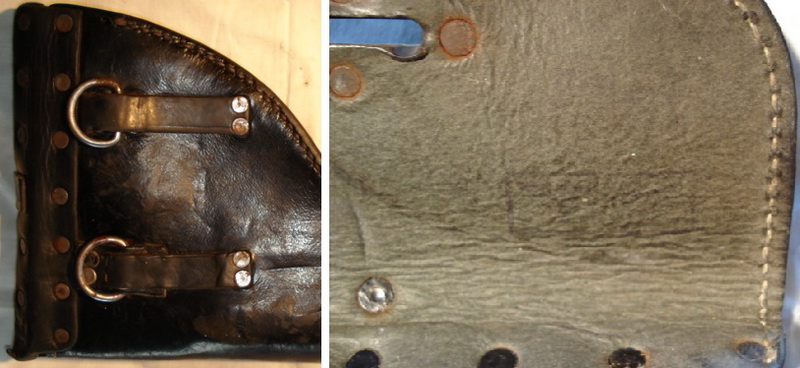
A 1944 dated
holster with belt loops and the cleaning rod strap riveted on. The
typical late war square WaA stamp can only be found on the
last specimens of the holster.

Rivets could also
be used for repairs. The ones above have replaced the stitching
that is underneath the folded over leather loop that also
holds the D-ring in position.
The flare gun holster was marked according to the model and branch of
the "user". The
leather holster was manufactured for the Wehrmacht from 1926
to 1940 and had the makers mark and WaA
applied to the rear between the belt loops most of the time.
If not present here it will be found inside
of the lid, most of the time to the left side, but it could be all over
the inside of the lid. The leather holster was manufactured until 1943
on Polizei contracts.

The
positioning of the markings seems to
be depending on the manufacturer. Most markings found on the inside of
the lid will be very hard to locate and read.
A complete list of all known makers & years is not within the
scope of this article, but here are those I have recorded until now:
| -A. Waldhausen Köln 1939 |
| -Karl Barth, Waldbröl 1937 |
| -Lederwarenwerk Curt Vogel, Cottbus 1936 |
| -Carl Busse, Mainz 1937 |
| -C. Weiss Braunschweig 1939 |
| -Kern Kläger & Cie (Berlin) 1939 / 1940 /
1941 /
1942 |
| -A. Fischer Berlin C.2 1937 / 1938 |
| -L. ZESCHKE NFLG, MÜLLROSE 1935 |
| -Robert Larsen, Berlin S.W.48. 1934 / 1938 |
| -C. POSE WEHRAUSRÜSTUNGEN 1938 |

The
police holsters have a Polizei
property
mark instead of the WaA, either a starburst, a stubby-winged eagle or
the improved stick-wing eagle that appeared in 1942. The two first ones
was normally found on the rear, the last one on the front under the
lid. (Photo courtesy of Greg Baker)
The Polizei holsters were manufactured
both in black and brown leather.
The Preßstoff holsters were all marked
to the inside of the lid (on the right side), with one documented
variation. Production of this holster model started in 1940.
From the start of April that year the three-letter code
system was introduced, so most of the Preßstoff
holsters are only marked with a
three-letter code, year digits and a WaA.
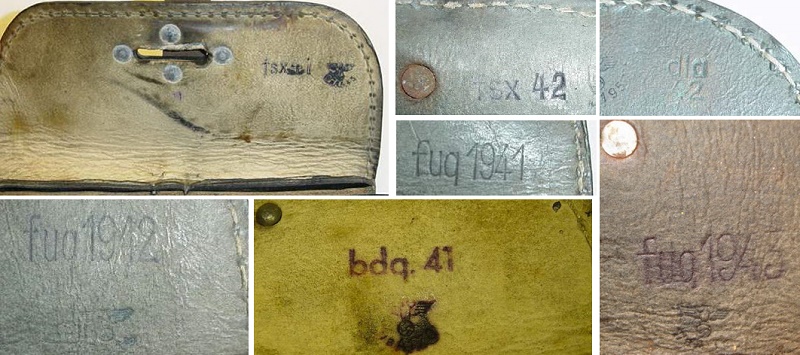
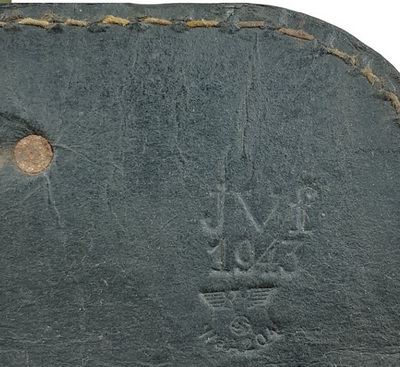
| -Gustav Buchmüller. Lederwaren-, Koffer- u.
Sattlerfabrik, Stuttgart |
| -Carl Weiss, Lederwarenfabrik, Braunschweig |
| -bdq. Erhardt & Kirsten, Koffer und
Lederwarenfabrik, Thüringen |
| -dla Karl Barth
Militäreffektenfabrik,
Gelsenkirchen |
| -fsx Albin Scholle
Lederwarenfabrik, Zeitz |
| -fuq Cottbusser Lederwarenwerk Curt
Vogel, Cottbus |
| -jvf Brand, Wilhelm, Treibriemenfahrik, Heidelberg |
Again, probably not a complete list, but the most
often
encountered makers and codes.
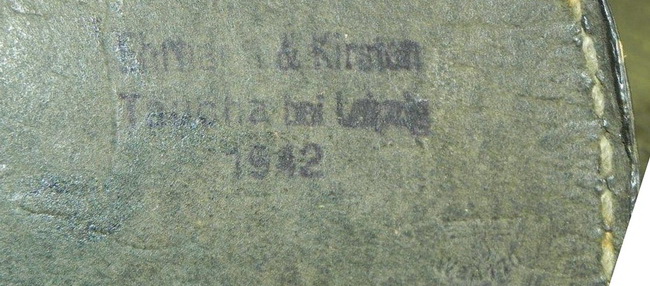
An interesting variation. bdq. 41 above is the same maker that stamps his full name and address in 1942. Both have a WaA.

Both
examples
shown above have had the leather lid hinge installed per regulations
after breakage occurred.
Three makers made the Preßstoff holsters
in 1940 and marked them with their full company name. The
first maker above is "Buchmüller,
Stuttgart, 1940" (code gna, never observed on any holsters),
the second one is C.
Weiss Braunschweig 1940 (code cww, never
observed on any holsters). Incidentally, these
two are also the only
holsters I
have ever seen from these makers made of Preßstoff.
The third maker was Curt
Vogel. He initially marked his holster in an oval with the full name
and address, but later changed to his designated code fuq.
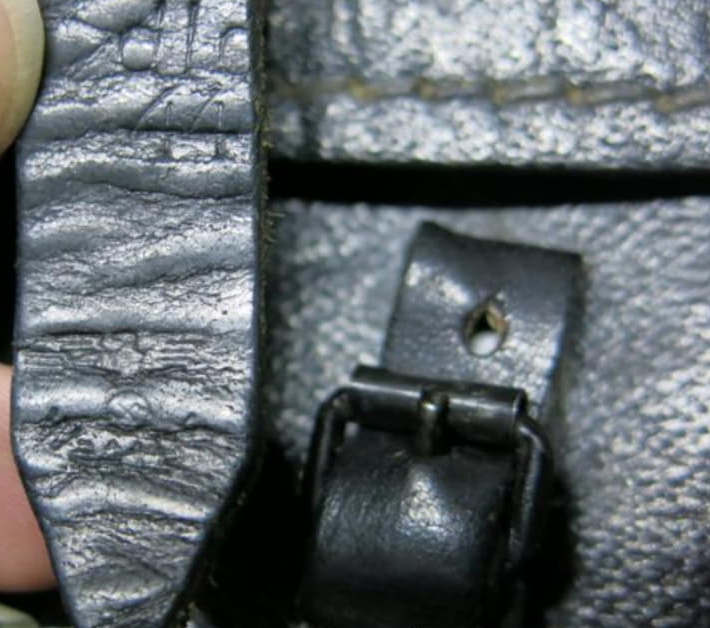
(Picture courtesy of Miguel at ersatzmilitaria.com)
The exception!
Pouches manufactured by dla (Karl Barth
Militäreffektenfabrik,
Gelsenkirchen) in 1944 were marked
with the maker's
code and WaA to the
tip of the tongue of the locking strap to the front.
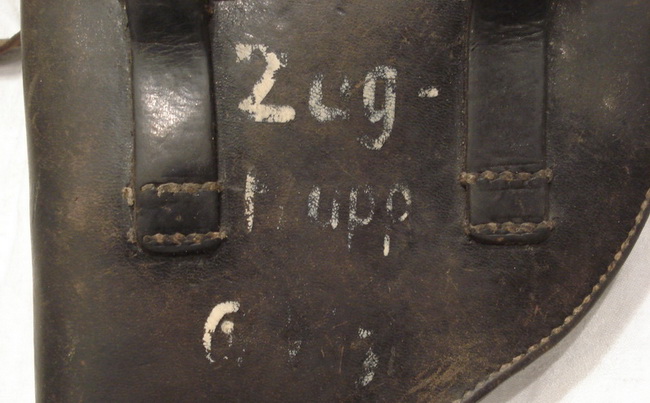
Some holsters were
also painted with the unit's name, to keep them in
the "right hands". The one above is sadly not legible anymore.
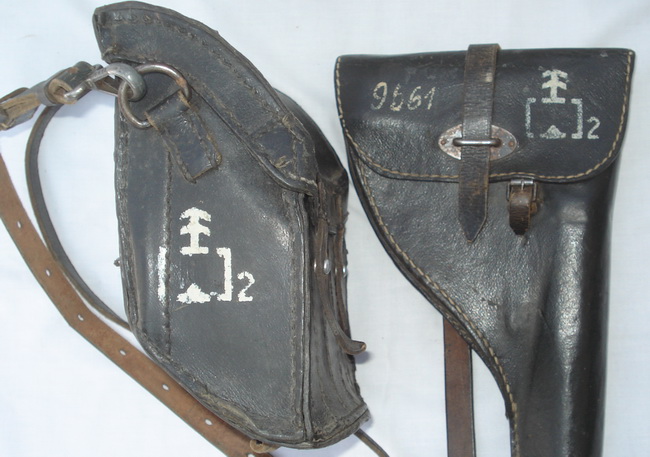
A dream-team! Holster and cartridge pouch both marked with a tactical
unit symbol as "property marking".
Carrying
strap
(N4816 Tragriemen)
The carrying strap for the holster and the cartridge pouch was made of
leather with either
a roller pin buckle or a friction lock to adjust the length,
and a carbine hook in each end. As a
general rule, they were issued with the holster or pouch and had manufacturer
and year markings that matched them.
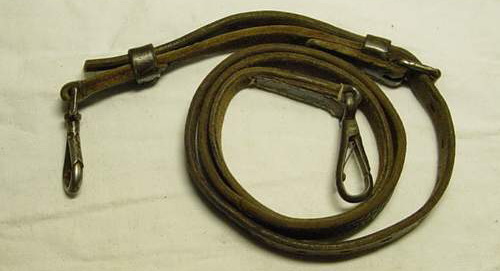
The first model was made of two parts, with the carbine hooks sewn to
the leather at each end. This sling could be split in two parts. The
earliest sling I have found was 1928 dated, but the hardware was
identical to the ones manufactured until the end of the war.
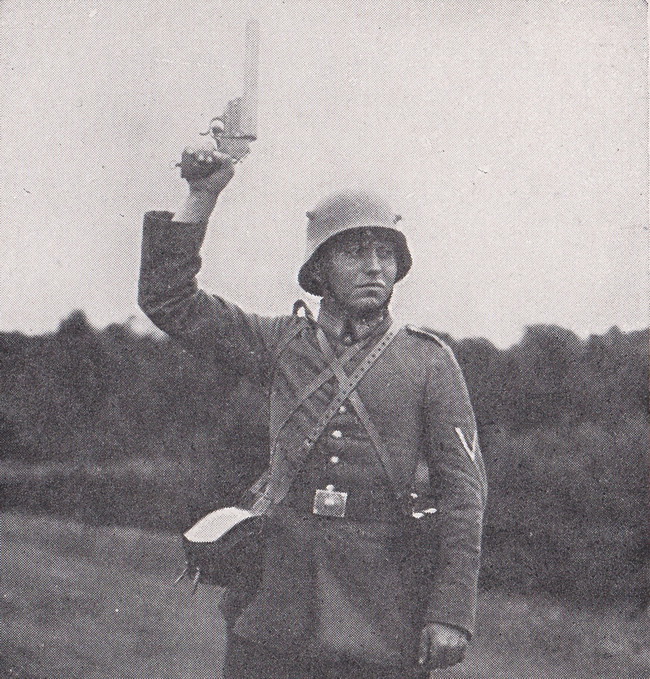
This picture is from the H.Dv. 409 from 1935 and shows the first type
of strap used with the cartridge pouch.
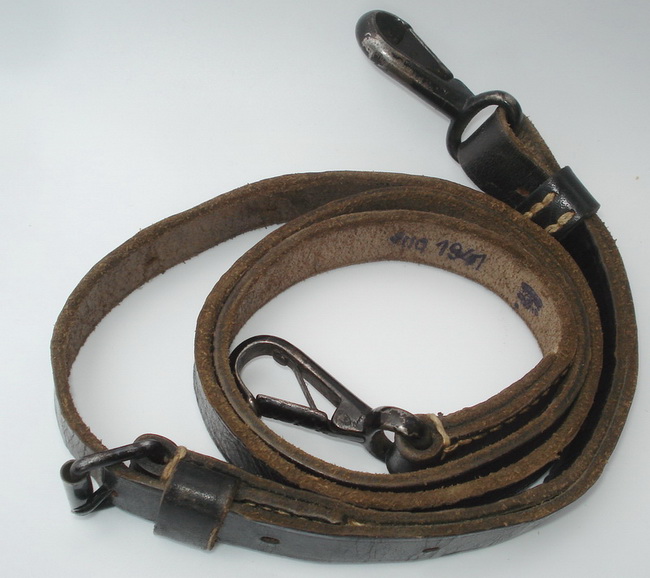
The second model was slightly easier to
manufacture, as only one of the two carbine hooks were sewn on, and it
had a better construction with no loose end.
As the war moved on the supply of hardware must have taken a turn for
the worse. In 1941 fuq (Cottbusser Lederwarenwerk Curt Vogel, Cottbus)
manufactured the standard sling (above), but a variation of the sling
can also be found with the same marking (fuq 1941), but with different
hardware (below).
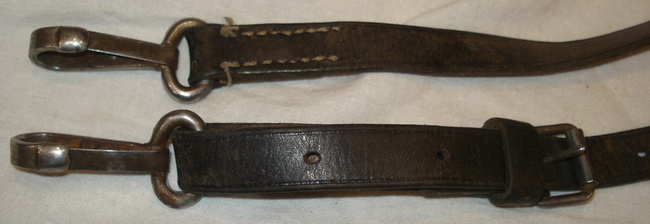
Over the years, several flare gun holsters have shown up with different
varieties of the carrying sling.
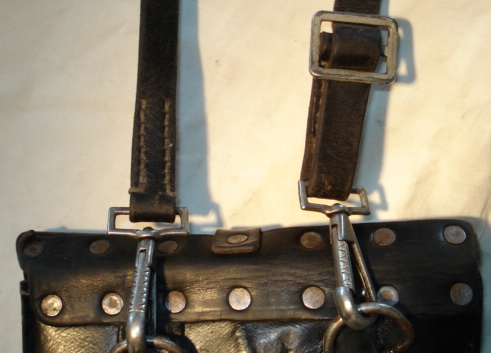
The one above
utilizes hardware that obviously doesn't fit the prescribed
width of the sling,
and the roller pin
buckle has now been substituted
with a friction buckle.
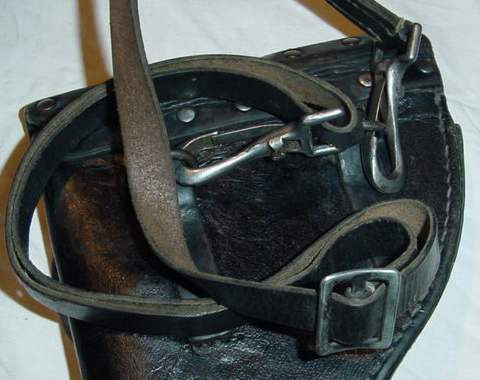
Yet another
variety.
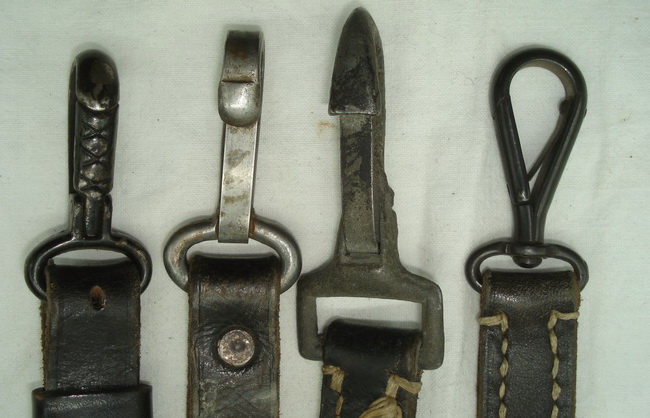
These 4 are the most common types of carbine hooks. Note that
number
two is a late war production sling that has been riveted
Ejector
rod (N4005
Wischstock, Stahl)
The ejector rod was constructed from several parts. The rod had a
handle to ensure that the operator got a firm grip, and a cylindrical
piston at the opposite end. This piston was at first made of brass, and later it was made of pure aluminum,
which both are softer materials than the steel or Duralumin barrel, to avoid wear to
the barrel. This piston was either used to clean the barrel or as a
manual ejector if a case got stuck after firing. The
ejector rod will often be referred to as a cleaning rod. A small
carbine
hook was stitched to the handle with a leather loop. This would prevent
the loss of the cleaning rod if it was issued with a flare gun without
a
holster. The user would then clip it to the D-ring on the bread bag or
onto a separate D-ring on his belt.
The first version were of
course in full length, matching the long barrels used up until
1935. When the barrels got their length
reduced the same
happened to the ejector rods; they were cut, shortened and soldered
together. The brass piston was either soldered to the handle or screwed on.

A early ejector rod that has
been shortened and soldered back together. Note the serial number (of the gun), piston head made of
brass and the non swiveling hook that will reappear in 1942.
It is not
known when the transition from brass to aluminum took place, but most
certainly prior to 1936. (Photo courtesy of Greg Baker).
The handle was welded on and shaped with a file up until 1936, when it
was soldered to the rod instead.
The ejector rod then remained unchanged in
production until 1942.

First model. Full
length, with welded handle (Photoshop picture).

Second model.
Reduced length, with welded handle.

Third model.
Soldered handle.
This is by far the most common model to find today.

Fourth model. J42,
One-piece, shaped handle.
In 1942 it was simplified by shaping the handle from
the same piece as the rod
just by bending it.
In 1942 a special new non-swivel carbine hook was used by the
manufacturer "J". This also required a broader leather
fixture.

Fifth model.
G.L.43. No carbine hook. Alloy used for piston.
The leather loop and the carbine hook were
omitted
from production in 1943, and the aluminum piston was replaced
with one made from
an
alloy.
In regulations
issued in July 1943, it was announced that the
ejector rod would
no longer be procured and that existing stocks should be
consumed. As an alternative, the user should make an improvised rod out
of
wood to remove the cases and to clean the barrel.

The ejector rod manufactured from 1936 and onwards for Wehrmacht were
all marked the same way. The ones ordered by the Polizei had a Polizei
property eagle on the thinnest part of the aluminum piston. In early
1936 the company "Gerhard" stamped their production on the lower arm
with "Gerhard 1936". Note the welded handle. The same year the
company G.L. marked their ejector rods on the upper arm, but with the
WaA on the flip side. Note the soldered arm/handle. The final
position of the maker's marking was then established in 1938 as the
upper
arm, with the WaA on the same side as the company initials.
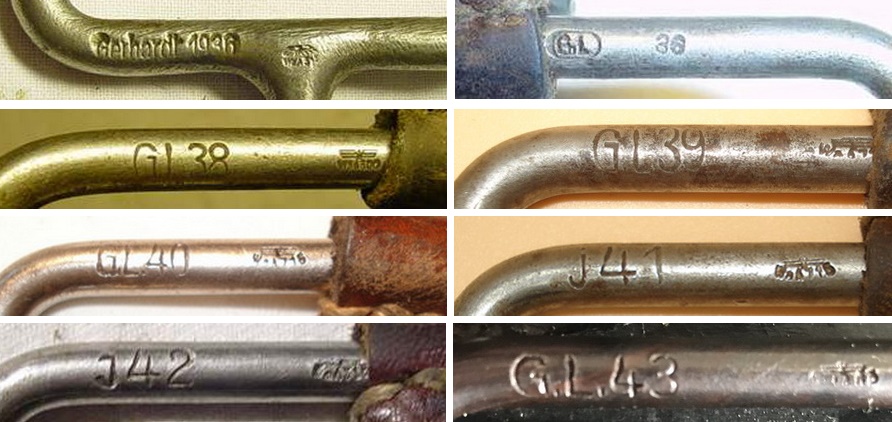
All known maker
marks from 1936 to 1943 on ejector rods manufactured
for the Wehrmacht. Note that J42 can be found on both the standard and
simplified model.
G.L.43 can only be
found on the simplified model, without the hook.
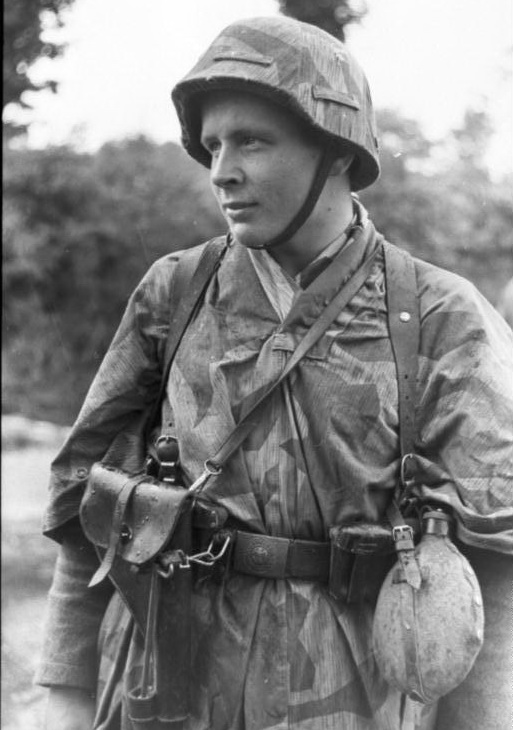
German soldier in
France, summer 1944. The flare gun is carried in a
standard leather case suspended from the correct strap.
To prevent the
holster from moving, he has clipped the small carbine hook on the
ejector rod to a D-ring in the belt.
Ammunition
Pouch (N4004 Tasche für Leucht- u.
Signalpatronen)
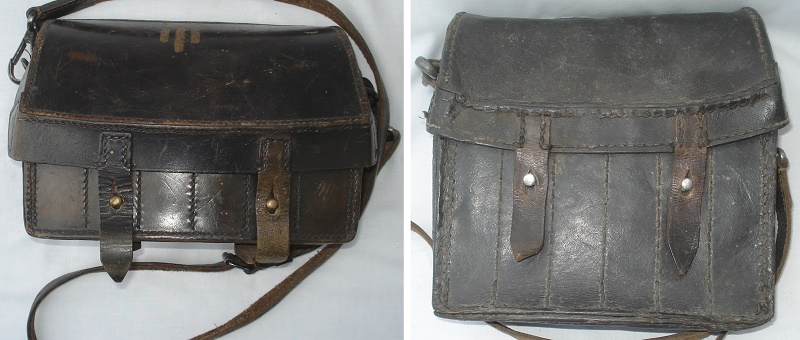
The ammunition pouch came in two main
models, the longer version replacing the shorter version in
production around 1941.
It had two belt loops at the back, and
D-rings at the sides for
attaching the
carbine hooks of the same type of carrying strap as used with the
holster. The
lid was closed using two
leather straps
that
were snapped on two buttons attached to the front of the holster.
Inside, the holster
had room for 18 cartridges, with a separate pocket for each
round.
Model 1
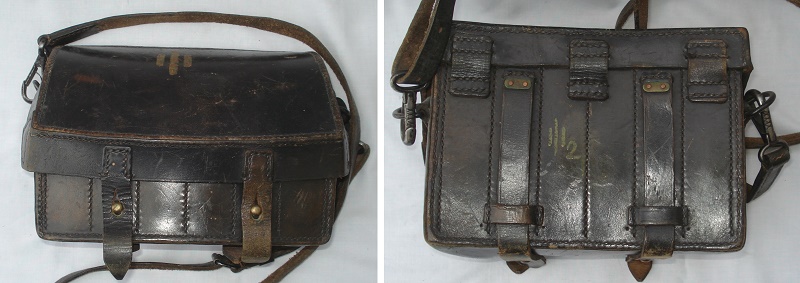
Note the tactical
symbol, painted to both the lid and the rear.
The first model was made of leather and
had a
flat
bottom. This pouch has been found marked
as early as 1926, and it is the pouch shown in all prewar manuals.
Pouches manufactured up
until 1937 had brass buttons on the front.
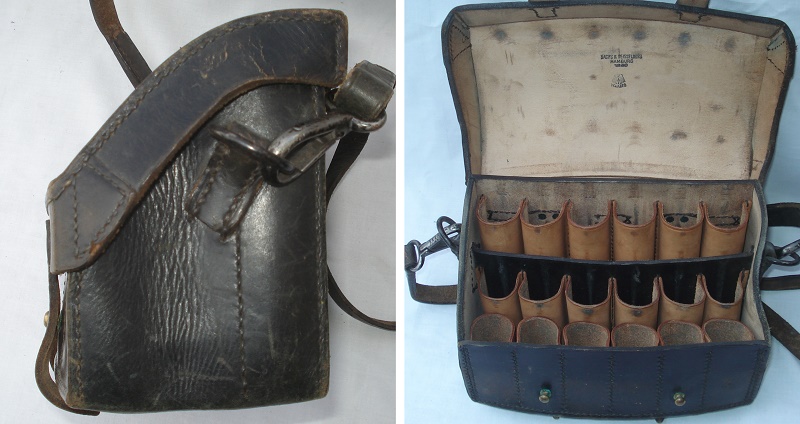
It could take 18 rounds of which only 6
could be of the long type. This was
due to the flat bottom and the sloping lid. On older specimens the maker's markings will
be located on the outside front of the lid, between the closing straps.
On the newer pouches the marking will be inside the
lid. In theory, a model 1 ammunition pouch in Preßstoff could exist, but I have never
seen one.
Model
2
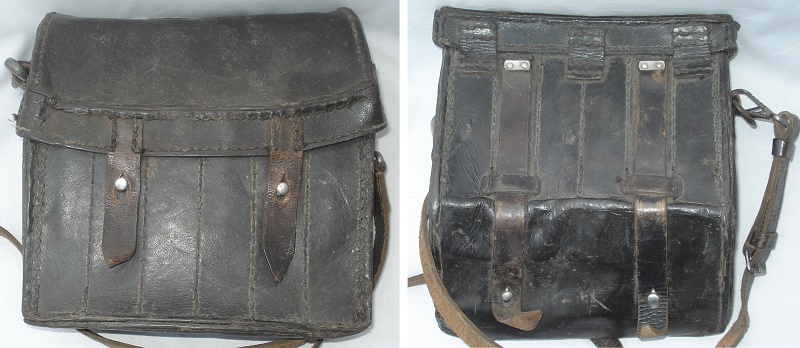
Model
2 made of Preßstoff
Just like the flare gun holster, the
shortage of real
leather also forced
a transition to artificial leather (Preßstoff) or canvas/web for the
ammunition
pouch. It was redesigned with a sloping bottom, allowing the
long cartridges to fit in all the pockets.
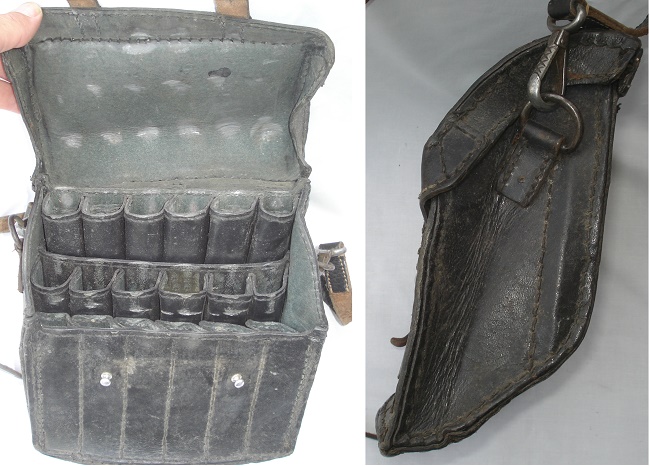
Model
2 made of Preßstoff
This way there was no
limit to the
number of
cartridges of each type it could hold. Apart from the sloping bottom
the design
remained
unchanged. The marking on this pouch was either placed on the left
outside panel, viewed from the front (bdq. 41) or inside the lid.

Model
2 made of Preßstoff
One interesting observation is that the
makers of these pouches are the same makers that
made the Preßstoff flare gun holsters, with one exception: 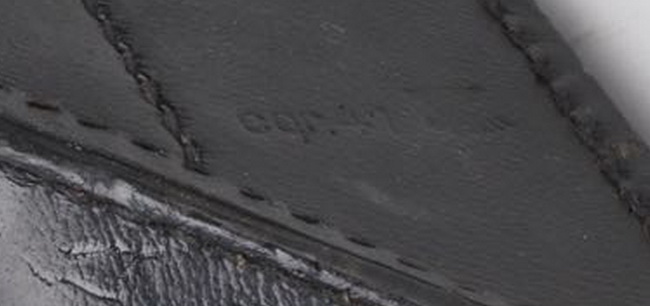
cqr. Lederwerk Sedina Joachim Schell, Sportartikelfabrik, Finkenwalde, Stettin
It is also worth noting that this model of
the holster was never
made in
leather during the war, but got a renaissance in the NVA (DDR's army)
after the
war, but were then always
manufactured in leather.
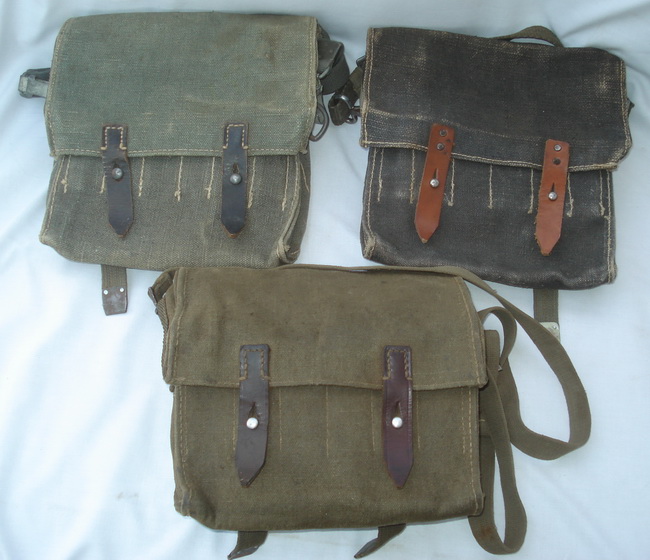
Model 2 made of
canvas/web, 3 different makers
The second model was also manufactured
in canvas/web from 1941, so it appears that the
manufacture of the long version started up in both Preßstoff and canvas/web at the same
time.
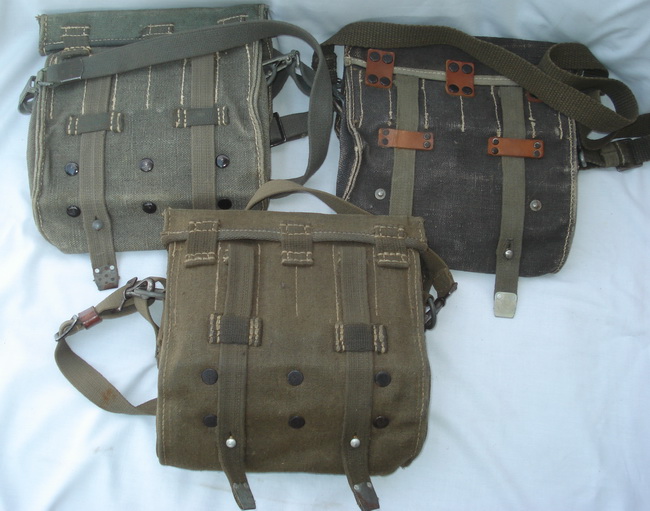
Belt loops and
straps were manufactured
in both
leather and webbing,
and were available as both sewn and riveted variants.

To
stiffen these and protect
the
cartridges, one or two strips made of wood were riveted
into the
bottom of the pouch.
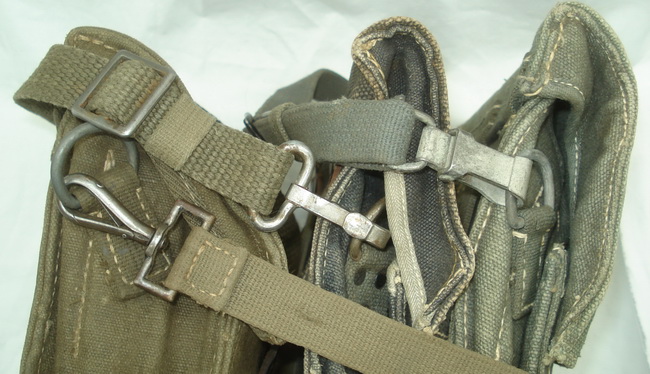
The
carrying straps for
these pouches
were made of webbing with various editions of carbine hooks.

No distinction was
made between the different models
of the cartridge pouch in the supply system. Both models of
the holster
had the same article number; it didn't matter if it was long or short,
made of
leather, Preßstoff or canvas/web.

The
canvas/web pouches were marked the same way. Either inside the lid, or
on the left side panel. The one pictured above of special
interest; fuq. This
maker made the flare gun holster in Preßstoff and the flare gun ammunition
pouch in canvas/web simultaneously in 1941 and 1942. (Photo courtesy of Greg Baker)
In 1935, by the
release of D. 409, the proposal
for the filling of the Tasche für Leucht- und Signalpatronen
was as
follows:
6 light cartridges
(front row)
2 single star
flare cartridges in each of the
following colors; red, green and yellow (middle row)
2 double-star flare
cartridges in each of the
following colors; red, green and yellow (back row)
With this setup, the
holster weighs 2.1 kg.
The content probably
changed significantly as new flare
cartridges were developed during the war.
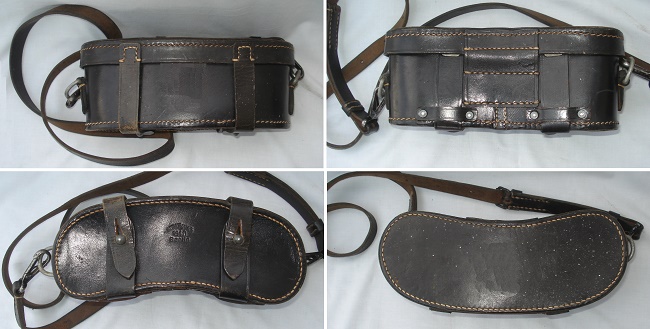
Another variant of
the leather holster was
kidney-shaped, and only accommodated 12 short cartridges.
However, this
was
only manufactured for the Polizei and is thus not covered by this
article.
Improvising
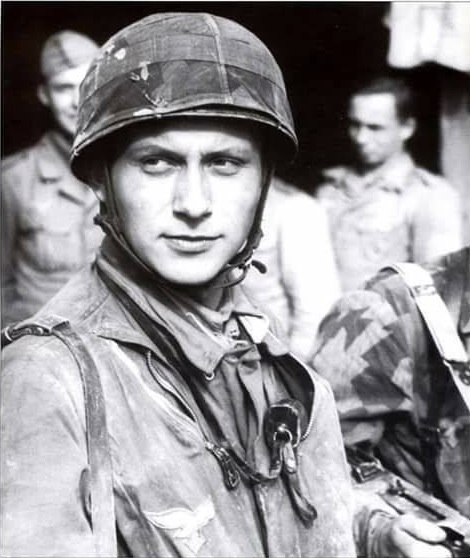
A Fallschirmjäger
in Tunisia with a Leuctpistole on a
lanyard. The
lanyard in use is in fact a standard binocular strap.
Also note the M1928A1 Thompson held by the Fallschirmjäger next to him.
Despite
the fact that the flare gun was fitted with a lanyard ring, a lanyard
was never
manufactured. (Yeah, I know; plenty of fanciful variants out there
for sale claiming to be).
Contemporary images show various
improvised solutions used as a lanyard,
such as a piece of string, ropes and leather straps.
Denckler
Verlag's educating pamphlet
states
that if the flare gun is not issued with a flare gun holster,
the user must do the following: Take
the bread bag strap (assuming the bread bag is attached to the belt)
and
attach
the carbine hook at one end to the lanyard ring on the flare gun. Hook
the other end to the D-ring on the bread bag. The strap should go over
the shoulder. The
flare gun
is then carried between the belt and the tunic. If you do not have a
cartridge pouch
for the flare cartridges, these must be carried in the bread
bag.
Codes
For tactical use,
all the different flares (apart from the white light) had a meaning, or
"sent a message". But this was also a fact that the enemy knew, so
the codes in use had to be switched often to avoid interpretation by
the enemy, or even worse; used by him. So for every operation and order
a new set of
codes had to be handed out.
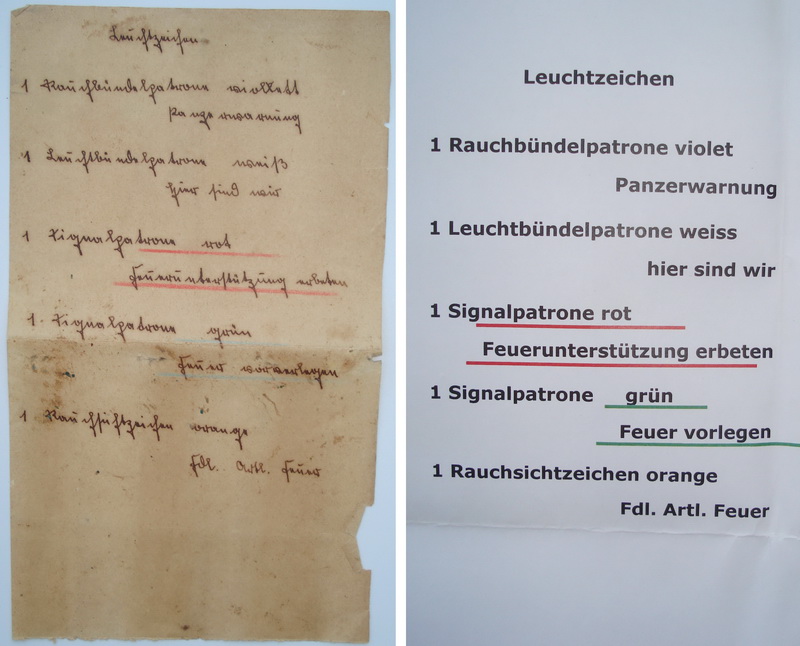
This note in Sütterlin script was found inside a flare cartridge
pouch (model 1) that had seen 40 years of postwar use in the
Norwegian Home Guard, without the note being removed! The
transcribed
text on the
right is
self-explanatory. Note that the last item is not a flare cartridge, but
the handheld orange smoke generator.
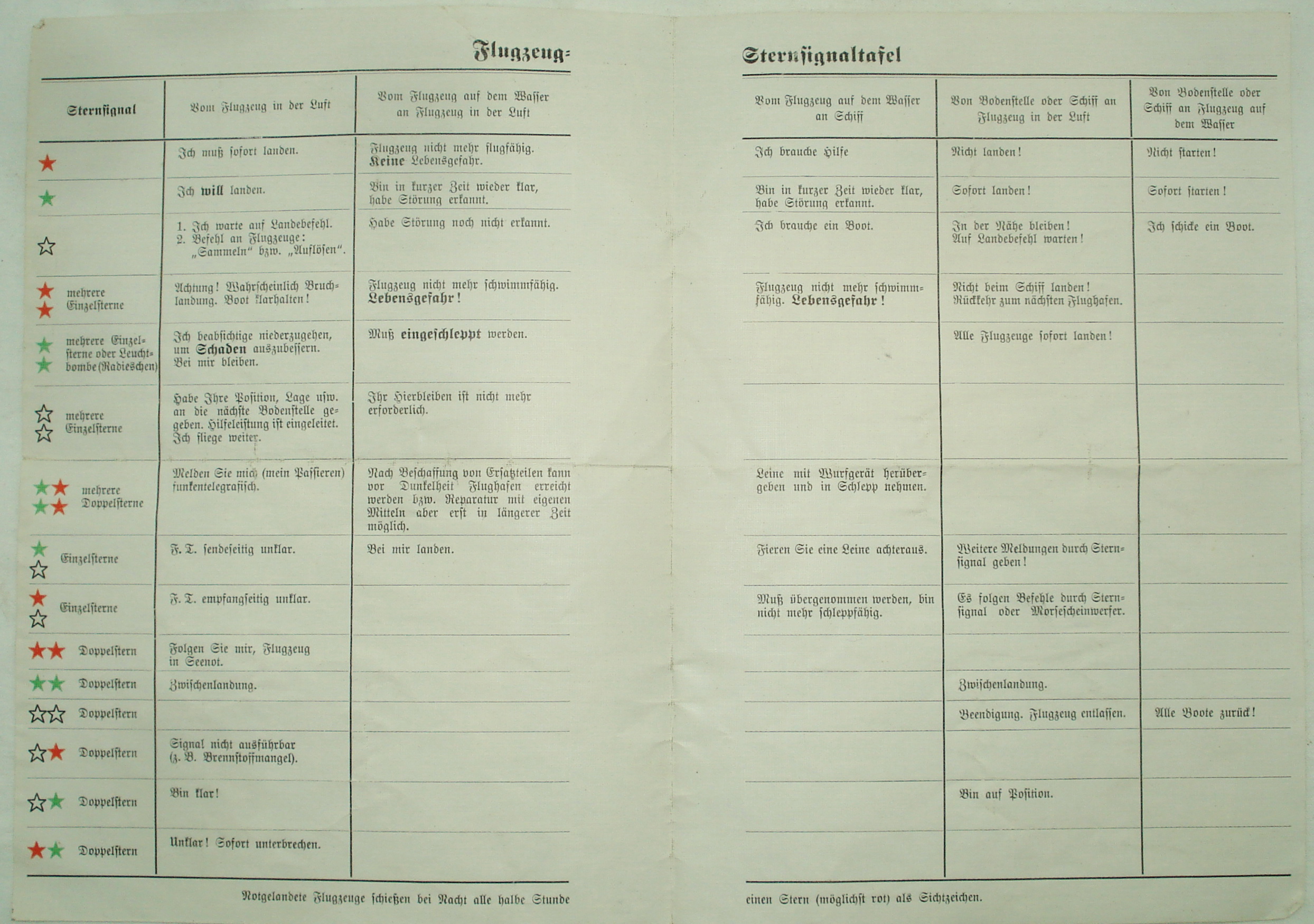
Click on the
picture to view a larger version.
In
the Luftwaffe and Kriegsmarine the flare gun signals had more permanent
"value". The chart above is printed on rubberized canvas and is a
predefined chart for flare gun signals relating to seaplanes and their
contact with other aircrafts and ships. This chart was discovered
inside a photo album that once belonged to a Lw seaplane pilot. I
assume it is very rare....
Part II:
Special
equipment

As
mentioned, the
flare gun was used by all branches, all with their special
needs for accessories. For
example,
this model was used extensively in the aircrafts
of the Luftwaffe, which
resulted in
their own ammunition containers for aircraft installation, ammunition
bandoleers
for flying personnel, fixed ports for shooting out of aircraft etc.
However, the
focus of this article is limited to Wehrmacht Heer and their use, so
the range
of equipment is somewhat limited. According to H.Dv 398 N5 the special
accessories was limited to the two sets described in this part.
As
far as the Kleine und Grosse
Werkzeugkasten für Waffenmeister table of contents shows, there was no
special
tool for repairing or measuring the flare gun. All repairs and
measurements
were made with standard tools (Handelsübliche Werkzeug).
Spare
parts box for flare gun (N4028 Vorratskasten für Leuchtpistolen)
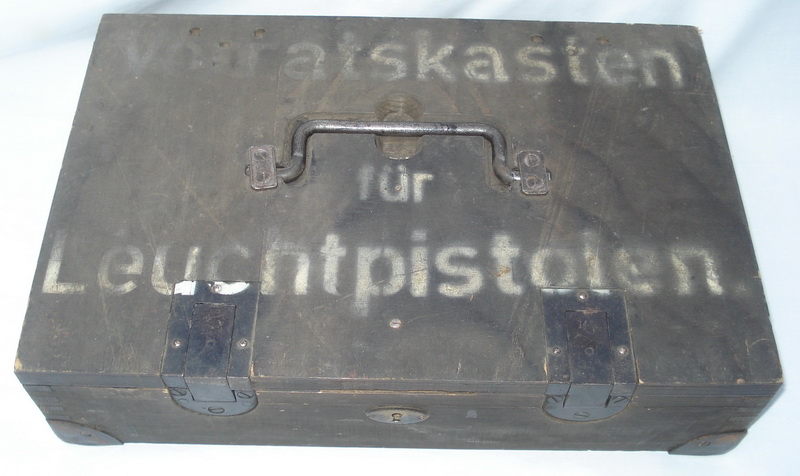

List of contents
for the spare
parts box
This
is the spare parts kit used by the Waffenmeister to replace
broken or damaged parts, or replace lost ones. According to the table
of
contents, the
box weighed 7.5 kg, and on 15 April 1942 cost the net sum of 101
Reichsmark and
50 Reichspfennig. In comparison, a Leuchtpistole without accessories
cost 25
Reichsmark and 75 Reichspfennig. The kit contained everything needed to
build 2 complete flare guns out of parts, as well as some extra wear
& tear parts. In addition,
it
contained two spare carrying straps for the flare gun holster or the
cartridge
pouch
(N2816). Frames and barrels were without serial numbers, but
otherwise
marked as usual with control and manufacturer markings, but the
parts did
not have the "Beschussamt" (Pressure-proofing) markings.
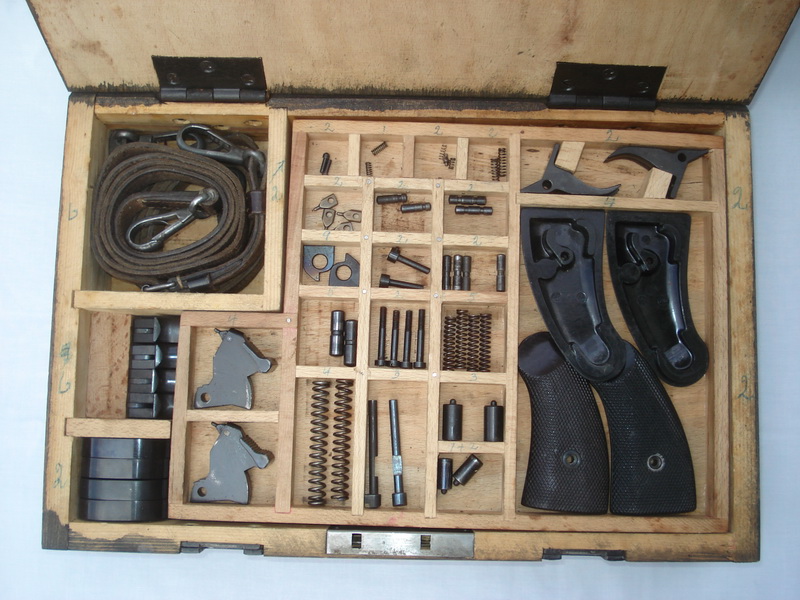
The kit
contained no tools. The
wooden box was lockable with a key in front and of a very simple
design to the
exterior, but with a relatively complicated interior.
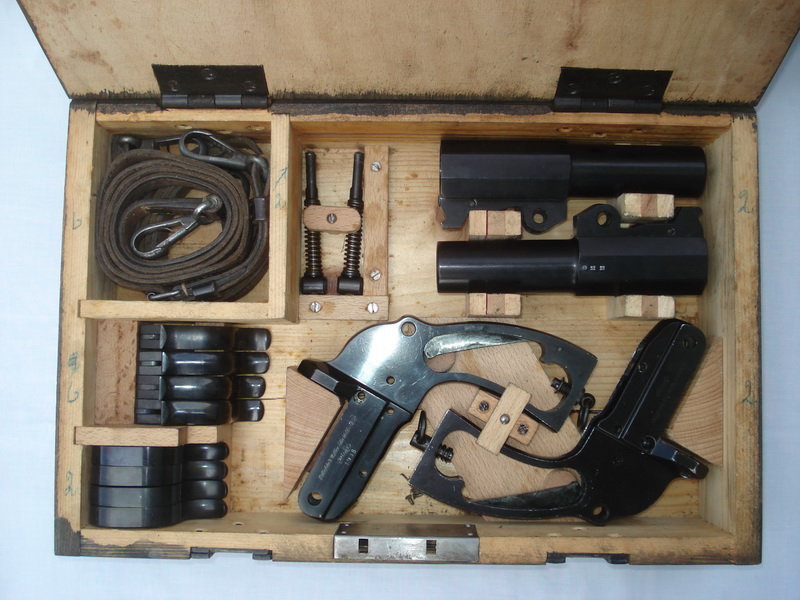
The
aforementioned
"subgroups" of parts had custom seats at the bottom of the box, such
as the complete hammer spring rod, trigger bar with the hammer pin
guide,
and the locking lever with rod and latch. Barrels and frames were
ingeniously held in custom-made holders. The removable tray on the top
contained a
number of square compartments for the various small parts.
Mounting
kit for the flare gun with pouch (N4027 Einspanneinrichtung
zur
Leuchtpistole, in Tasche)
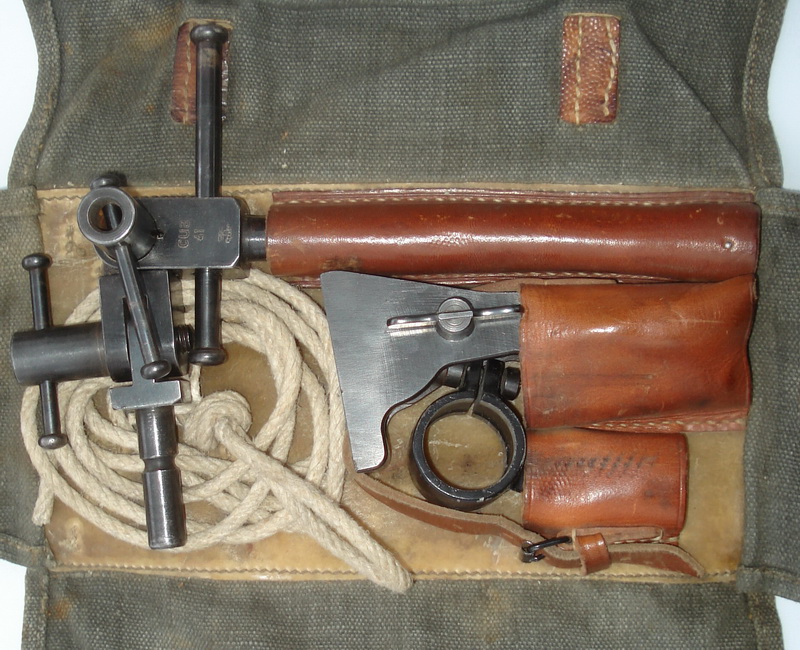 Mounting kit for
vertical firing
of the flare gun.
(Photo courtesy of Tom Ødemark)
Mounting kit for
vertical firing
of the flare gun.
(Photo courtesy of Tom Ødemark)
This is a kit for mounting the flare gun on a
tripod
or object (a tree, a railing, a table, etc.) in order to fire a single
shot
vertically. The kit consists of a clamping piece, a
threaded & jointed screw, a water level, a pull cord and a
canvas carrying case. The
first
edition of the kit came in a transport box instead of the canvas
holster, but
these boxes were already "out of date" in 1935 and were supposed to be
"used up". The kit had to be
used when shooting the Messpatrone (M-Patrone, measuring cartridges)
used for field
measurements for artillery units. The
M-Patrone has the odd property of
glowing from
the start and outwards, thus "drawing a bright line" from the barrel
and vertically upwards in the sky. Thus, observers from other positions
will easily
be able to reset their instruments from the illuminating line
and then
measure
angles with that as a zeroing point. To get a vertical flight path,
the M-Patronen is
constructed with a very powerful propulsion charge, which in turn
gives powerful recoil. Due to this it was not allowed to shoot
M-Patrone from a
handheld flare gun, as the recoil will cause injury to personnel, and
it would be very tricky to get that perfect vertical shot.
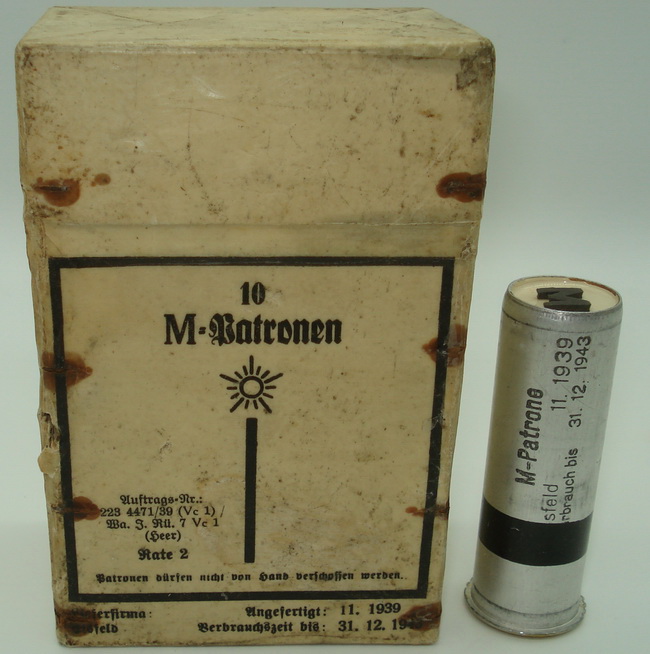
A box of
M-Patronen. Note the warning "Patronen dürfen nicht von Hand
verschossen werden".
But
the mounting kit
was also used for other
purposes by other units, although not necessarily required.
It was used for the R-Patrone (Rauch,
smoke) for
simulation of artillery fire. The R-Patrone shoots a small
explosive
charge that explodes after 70 meters, leaving a small cloud of smoke.
It is
recommended shot vertically from the tripod, but can also be shot from
the hand
according to D. 409.
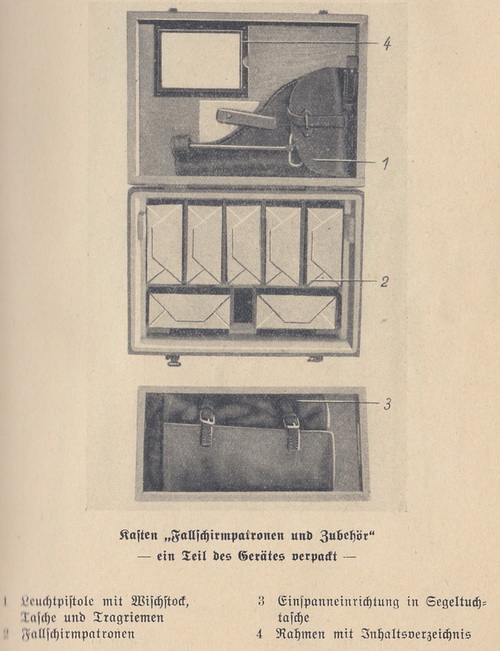
For use in the
regular weather service, it could
be used to launch the Fallschirm cartridge to calculate wind
direction and
wind speed in the mean air layers. It was then a part of the
Bodenmeßgerät,
Satz b. The kit contained a flare gun with accessories, a mounting kit,
a tripod
(Gestell 40) and 70 Fallschirm cartridges. The parachute cartridge
could
only be used in daylight, as it contained no light source. The
cartridge
has a
container that shoots up to 70 meters in height, where an ejector
charge
releases a red parachute with a 1 meter long white tape that hangs
underneath.
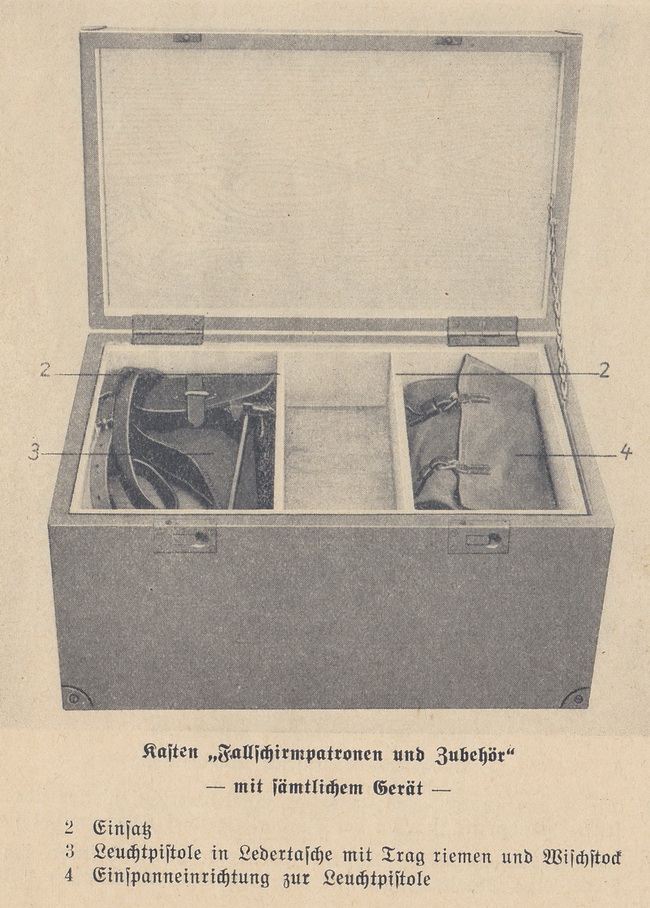
It was also part of
the more specialized
"Wettergerät für Nebeltruppe", where the wind was of great importance
for whether the smoke would be effective or not. In this kit the number
of
the
Fallschirm cartridges was doubled to 140.
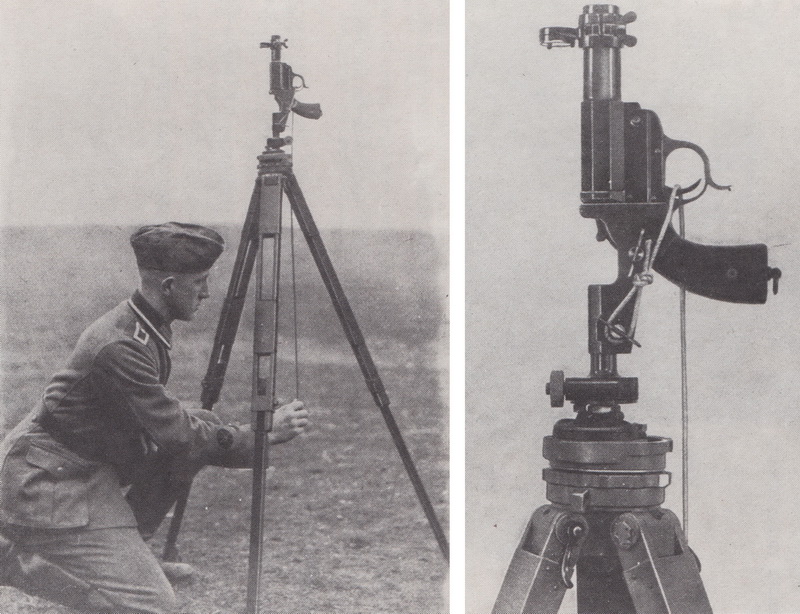
The preferred method was to mount the flare gun in the clamp piece and
the clamp
piece on a tripod. The tripod provides
much better options for alignment and stability than the jointed screw,
which
was really best as an emergency solution. The tripod was of a
standardized type
that was used for several types of optics, such as the aiming circle
and the battery
binoculars.
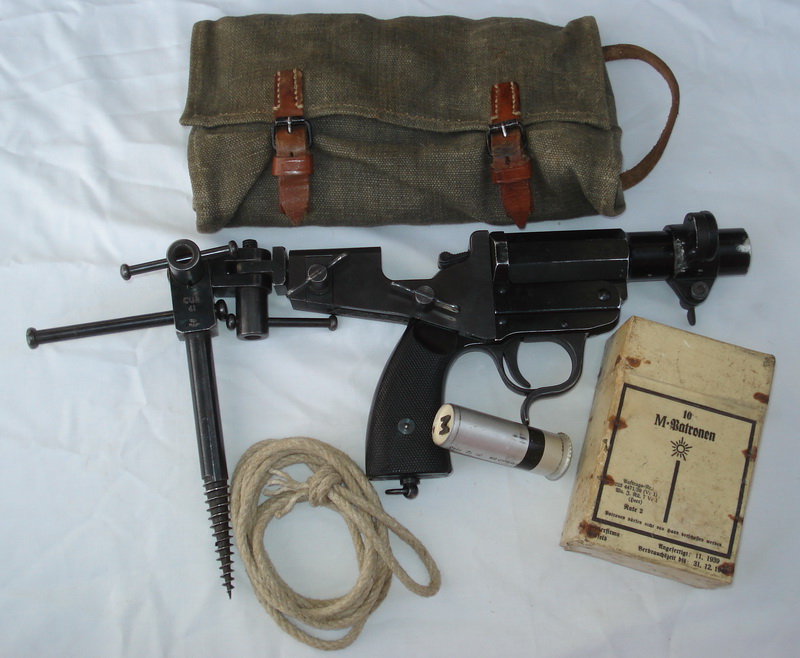
The
Einspanneinrichtung zur Leuchtpistole mounted on a Leuchtpistole, shown
with M-Patronen.
The kit consisted of five parts: Abzugleine, Einspannklaue, Libelle,
Doppelgelenkbaumschraube and Tasche aus segelleinen.
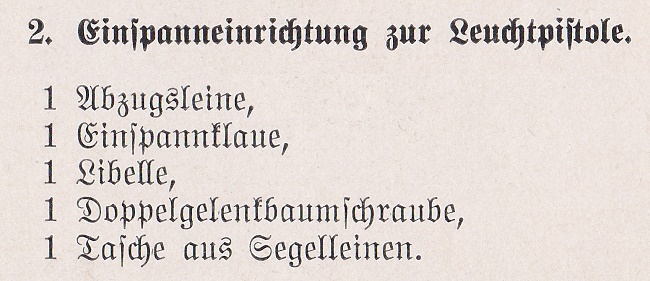
The Abzugleine was a simple rope, 1
meter long and 5mm thick, and simply used to remotely pull the trigger
as shown in the manual pictures above. It was threaded through the
finger guard and then anchored to the tripod or Einspannklaue. The rope
was then placed lying on top of the trigger and simply pulled downwards
to fire the flare gun
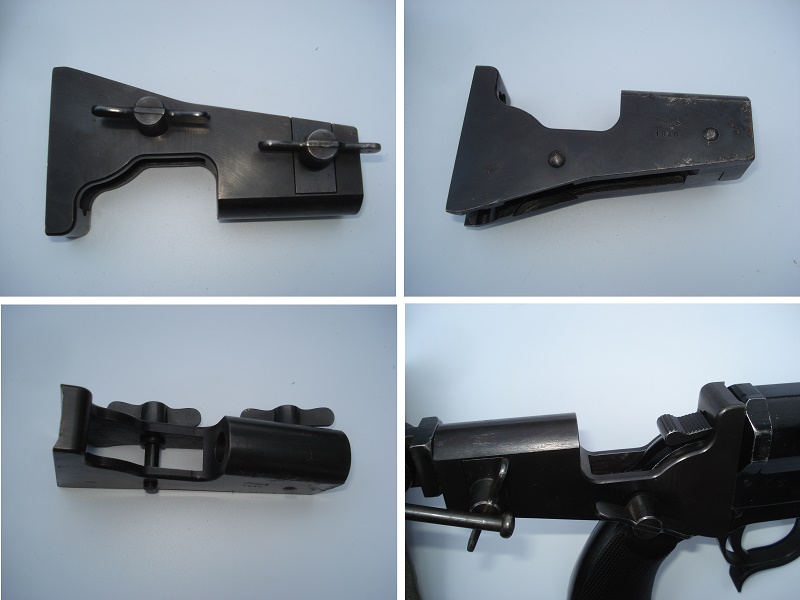 The Einspannklaue was machined from one piece of
steel, and had
two butterfly head bolts. One to hold
the flare gun attached, and one
to
attach the clamping piece to a tripod or the Doppelgelenkbaumschraube.
The Einspannklaue was machined from one piece of
steel, and had
two butterfly head bolts. One to hold
the flare gun attached, and one
to
attach the clamping piece to a tripod or the Doppelgelenkbaumschraube.
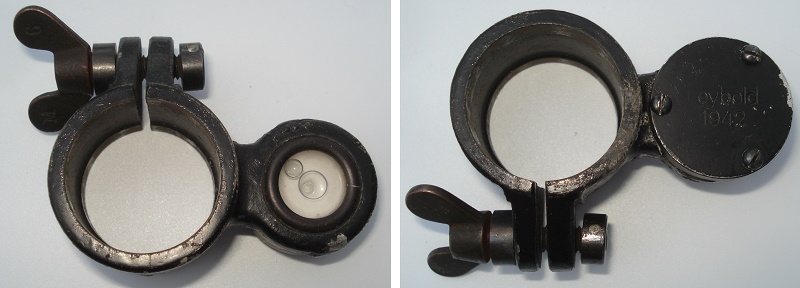
The
Libelle was made from an alloy, and had a water level in a separate
housing. The Libelle was slipped over the barrel and tightened
with a butterfly head bolt. This water
level ensured that the barrel was
pointing straight up. It was not necessary to remove it prior to firing.
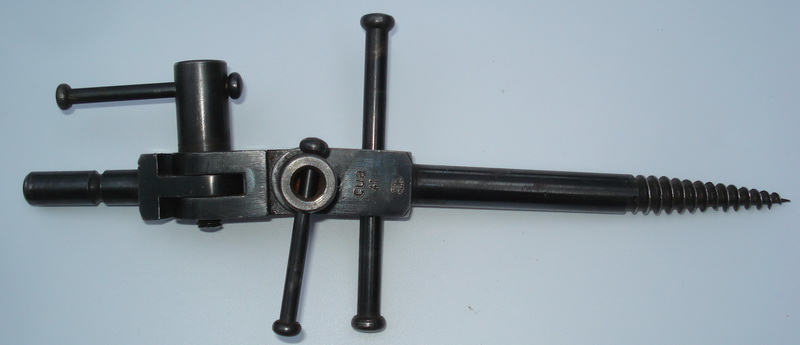
The Doppelgelenkbaumschraube
(Double-jointed-woodscrew) could be screwed into any wooden object
( a
tree, a railing, a table, etc.) to hold the Einspannklaue and the flare
gun. By adjusting it at the joints it was possible to get the
flare gun totally vertical.
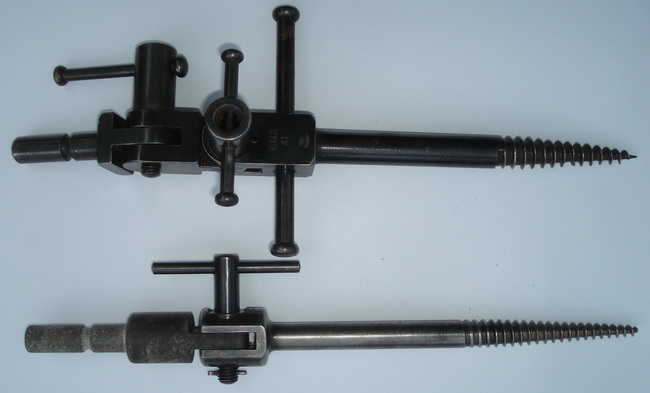
This
screw is often mixed with the "Baumschraube" (the lower of the two
above), that was part of the
Scherenfernrohr 14z kit. The Baumschraube was not suitable for this use
though, as it was single-jointed and much more "lightweight", with an
alloy head that wasn't designed to take the beating.
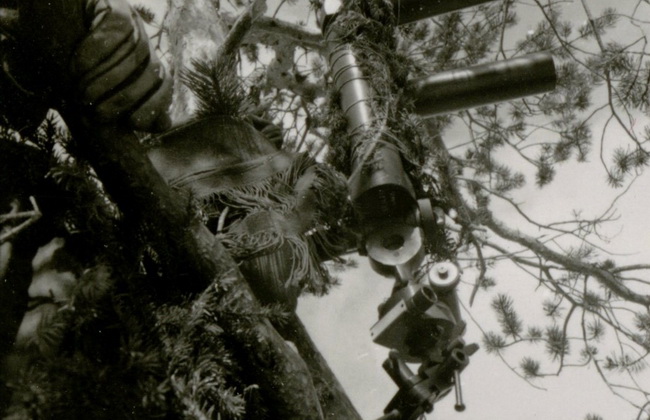
Here
the situation is the otherway around. A "Reynhardt Heidrich" artillery
observer in a tree-top in Finland is using a Doppelgelenkbaumschraube
instead of the prescribed Baumschraube for his Scherenfernrohr 14z.
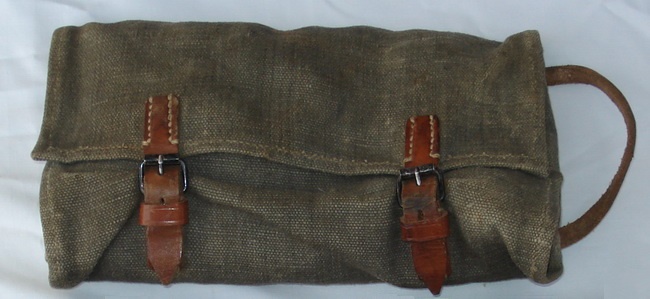
All
parts were stored in the canvas bag, which had its
own
pockets for each part. It was
fitted
with a carry handle on the top and belt loops on the back.
The kit was primarily used for field
measurements and indirectly for the weather service in the field
artillery,
and due to this it is relatively rare. It weighed a total of
about 2 kg and in
April 1942
it cost 27 Reichsmark and 40 Reichspfennig through the supply system,
ie only a little more than
a flare
gun without accessories. This kit was also offered on the prewar
civilian market
along with the flare gun, but only as separate parts, and without the
canvas bag and libelle.
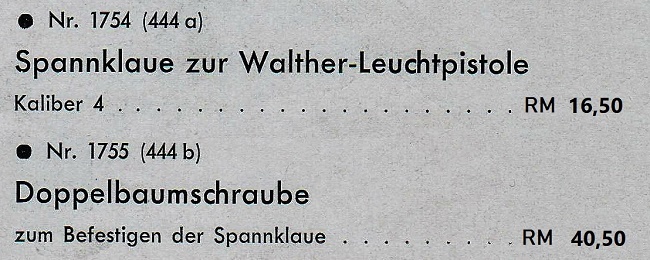
|


 Accessories
and equipment for Die Leuchtpistole
Accessories
and equipment for Die Leuchtpistole